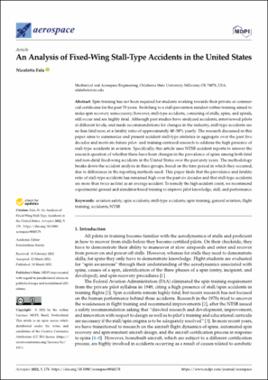| dc.contributor.author | Fala, Nicoletta | |
| dc.contributor.editor | Kontis, Konstantinos | |
| dc.date.accessioned | 2022-03-29T13:35:25Z | |
| dc.date.available | 2022-03-29T13:35:25Z | |
| dc.date.issued | 2022-03-24 | |
| dc.identifier | oksd_fala_analysisoffixedwing_2022 | |
| dc.identifier.citation | Fala, N. (2022). An analysis of fixed-wing stall-type accidents in the United States. Aerospace, 9(4). https://doi.org/10.3390/aerospace9040178 | |
| dc.identifier.uri | https://hdl.handle.net/11244/335097 | |
| dc.description.abstract | Spin training has not been required for students working towards their private or commercial certificates for the past 70 years. Switching to a stall-prevention mindset within training aimed to make spin recovery unnecessary; however, stall-type accidents, consisting of stalls, spins, and spirals, still occur and are highly fatal. Although past studies have analyzed accidents, interviewed pilots at different levels, and made recommendations for changes in the industry, stall-type accidents are no less fatal now, at a fatality ratio of approximately 40-50% yearly. The research discussed in this paper aims to summarize and present accident stall-type statistics in aggregate over the past five decades and motivate future pilot- and training-centered research to address the high presence of stall-type accidents in aviation. Specifically, this article uses NTSB accident reports to answer the research question of whether there have been changes in the prevalence of spins among both fatal and non-datal fixed-wing accidents in the United States over the past sixty years. The methodology breaks down the accident analysis in three groups, based on the time period in which they occurred, due to differences in the reporting methods used. This paper finds that the prevalence and fatality ratio of stall-type accidents has remained high over the past six decades and that stall-type accidents are more than twice as fatal as an average accident. To remedy the high accident count, we recommend experimental ground and simulator-based training to improve pilot knowledge, skill, and performance. | |
| dc.format | application/pdf | |
| dc.language | en_US | |
| dc.publisher | Multidisciplinary Digital Publishing Institute (MDPI) | |
| dc.relation.ispartof | Aerospace, 9 (4) | |
| dc.rights | This material has been previously published. In the Oklahoma State University Library's institutional repository this version is made available through the open access principles and the terms of agreement/consent between the author(s) and the publisher. The permission policy on the use, reproduction or distribution of the material falls under fair use for educational, scholarship, and research purposes. Contact Digital Resources and Discovery Services at lib-dls@okstate.edu or 405-744-9161 for further information. | |
| dc.title | Analysis of fixed-wing stall-type accidents in the United States | |
| dc.date.updated | 2022-03-24T17:06:02Z | |
| osu.filename | oksd_fala_analysisoffixedwing_2022.pdf | |
| dc.description.peerreview | Peer reviewed | |
| dc.identifier.doi | 10.3390/aerospace9040178 | |
| dc.description.department | Mechanical and Aerospace Engineering | |
| dc.type.genre | Article | |
| dc.type.material | Text | |
| dc.subject.keywords | aviation safety | |
| dc.subject.keywords | spin accidents | |
| dc.subject.keywords | stall-type accidents | |
| dc.subject.keywords | spin training | |
| dc.subject.keywords | general aviation | |
| dc.subject.keywords | flight training | |
| dc.subject.keywords | accidents | |
| dc.subject.keywords | NTSB | |
| dc.rights.license | https://creativecommons.org/licenses/by/4.0/ | |
| dc.relation.oaurl | https://www.mdpi.com/2226-4310/9/4/178/pdf | |
| dc.identifier.author | ORCID: 0000-0002-7392-4904 (Fala, Nicoletta) | |
| dc.identifier.author | ScopusID: 57164785600 (Fala, Nicoletta) | |
